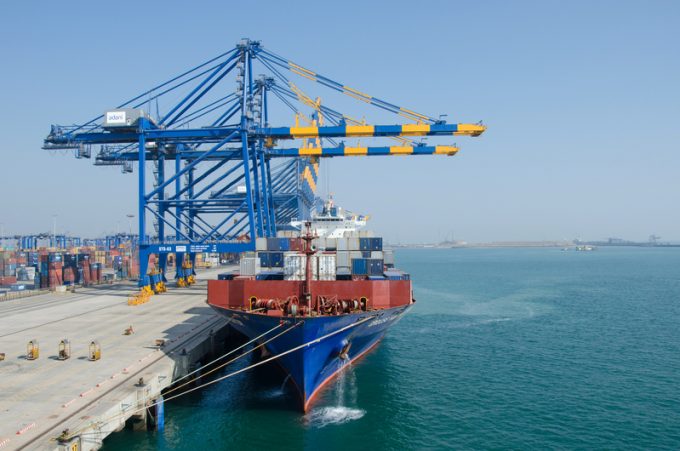Strong gains on the transpacific as US imports swell and GRIs begin to bite
Container spot freight rates on the key transpacific eastbound trade have started 2025 with strong ...
FDX: ABOUT USPS PRIVATISATIONFDX: CCO VIEWFDX: LOWER GUIDANCE FDX: DISRUPTING AIR FREIGHTFDX: FOCUS ON KEY VERTICALFDX: LTL OUTLOOKGXO: NEW LOW LINE: NEW LOW FDX: INDUSTRIAL WOESFDX: HEALTH CHECKFDX: TRADING UPDATEWMT: GREEN WOESFDX: FREIGHT BREAK-UPFDX: WAITING FOR THE SPINHON: BREAK-UP ALLUREDSV: BREACHING SUPPORTVW: BOLT-ON DEALAMZN: TOP PICK
FDX: ABOUT USPS PRIVATISATIONFDX: CCO VIEWFDX: LOWER GUIDANCE FDX: DISRUPTING AIR FREIGHTFDX: FOCUS ON KEY VERTICALFDX: LTL OUTLOOKGXO: NEW LOW LINE: NEW LOW FDX: INDUSTRIAL WOESFDX: HEALTH CHECKFDX: TRADING UPDATEWMT: GREEN WOESFDX: FREIGHT BREAK-UPFDX: WAITING FOR THE SPINHON: BREAK-UP ALLUREDSV: BREACHING SUPPORTVW: BOLT-ON DEALAMZN: TOP PICK

In a sign of scepticism about market behaviour, CMA CGM has pushed back implementation of a peak season surcharge (PSS) on India-US containerised cargo, planned for next week, to next month.
The levy of $800 per teu, $1,000 per feu and $1,200 for hi-cube loads (including reefers) will now start on 1 July.
CMA CGM Agencies (India) told customers: “The PSS will apply to tariff or service contract rates on all cargo moving under the scope of this tariff, from/via India, Pakistan, Sri Lanka, the Middle East Gulf, Red Sea and Egypt ports of load to USEC, USGC and all inland destinations reached via said ports.”
CMA CGM was the first carrier to announce a PSS on the tradelane, although its peers have made attempts to prop up rates in the form of GRIs. Indian exporters, battling demand headwinds, were hit by two GRIs of $500/teu each, on average, first on 29 March and then on 1 May.
However, average rates have seen no noticeable uptick and, on the other hand, the latest market trends indicate a substantial slide from end-May averages.
According to freight forwarder sources in Mumbai, India-USEC booking rates offered by CMA CGM to regular clients have fallen to about $1,600/teu and $1,850/feu from the average selling levels of $1,700 and $2,100 two weeks ago.
Sources also reported that all major carriers had serious challenges reaching vessel space allocations out of India, amid the slowing export market, which has, arguably, prompted further downward price adjustments.
Indian exports, by value, took a deep cut in April, down 13% year on year, to some $35bn, according to government data. Online equipment logistics platform Container xChange recently noted that Indian ports were experiencing heavy empty inventory levels due to slumping export demand.
“There is a noticeable decline in consumer demand from the US, EU and UK markets,” said Supal Shah, CEO of Mumbai-based Arcon, a subsidiary of Sarjak Container Lines.
As a result, average container prices at major Indian port locations, such as Nhava Sheva, Mundra and Chennai, nearly halved in April, year on year, according to the analysis.
Container xChange, however, said it expected some sort of a rally in Indian export volumes from next month. It said: “The third quarter is expected to bring improvements as fresh orders and bookings increase in preparation for the upcoming festival and new year season.”
Local industry groups, including the Federation of Indian Export Organisations (FIEO), also expressed such optimism. It called on the Indian government to extend more policy-level support for export trade stakeholders, particularly the reintroduction of Goods and Services Tax (GST) exemptions for ocean/air freight charges – a window the government removed in October.
“The need of the hour is to provide marketing support for further promoting ‘brand India’ products and services globally,” said FIEO president A Sakthivel.
Meanwhile, container volumes at Indian ports in May were down to some 1.86m teu, from 1.89m teu in April, reflecting a 1.7% decline, the latest figures show.
You can contact the writer at [email protected].
Comment on this article